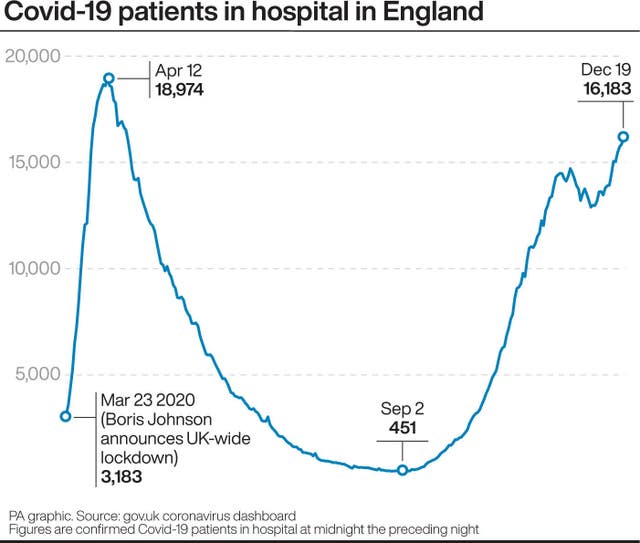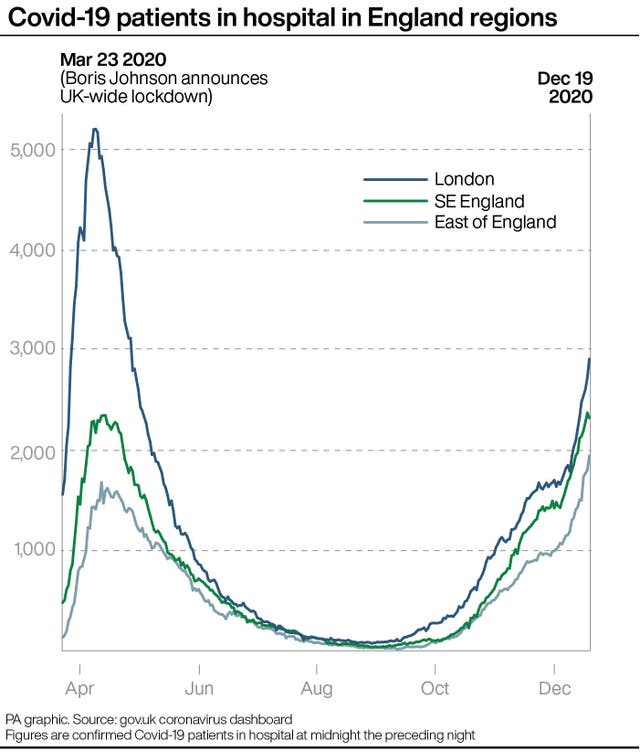A third of major hospital trusts in England currently have more coronavirus (Covid-19) patients than at the peak of the first wave of the virus, new analysis shows.
Second peak
In two regions – the East and South West of England – more than half of trusts are above their first-wave peak. Other trusts have seen their numbers rise so rapidly that they could pass their first-wave peak within days.
The analysis by the PA news agency found that of the 127 acute hospital trusts with a 24-hour (type 1) A&E department in England, 42 (33%) had more coronavirus patients on 18 December than at the peak of the first wave in the spring.
Examples include:
- Mid & South Essex, which recorded 450 confirmed coronavirus patients on 18 December compared with a first-wave peak of 374.
- East Suffolk & North Essex, which had 185 patients compared with a first-wave peak of 143.
- Barking, Havering & Redbridge, where there were 300 patients on 18 December versus a first-wave peak of 245. This is currently the only trust in London to have passed the peak.
- Gloucestershire, which had 171 patients compared with a first-wave peak of 149.

In other areas of England, such as the North West, some trusts saw numbers hit a record high in the autumn before dropping more recently. An example is Liverpool University Hospitals Trust, which saw a peak of 475 patients on 30 October but where the number now stands at 136.
But even in this region a handful of acute trusts are currently experiencing a new peak in coronavirus patients, such as University Hospitals of Morecambe Bay.
Here the number stood at 180 on 18 December, compared with a first-wave peak of 147.
Acute trusts manage all the major hospitals in England with A&E departments, inpatient and outpatient surgery, and specialist medical care.

Rising numbers
The total number of coronavirus patients in all hospitals in England – including mental health and community trusts – currently stands at 16,183.
During the first wave this number peaked at 18,974 on 12 April.
Four of the seven NHS regions in England have seen their total number of coronavirus hospital patients hit a peak in recent weeks.
On 16 November, new records were set in the North West and North East of England, though both of these regions have since seen a slight fall in total patients.
In the South East and East of England, new peaks were reached in the past few days.

In the Midlands, the number of patients has remained just above 3,000 for the past few weeks, near its first-wave peak of 3,430.
And in south-west England the current number is 1,051, slightly under the first-wave peak of 1,080.
Sharp rise
Only in London is the level of coronavirus patients well below that seen during the first wave of the virus – though here numbers have started to rise sharply.
Some 2,909 patients were recorded in the capital on 19 December, up from 2,092 a week ago.
The first-wave peak in London was 5,201 patients on 9 April.










